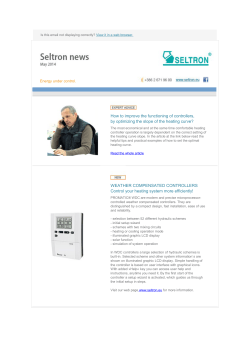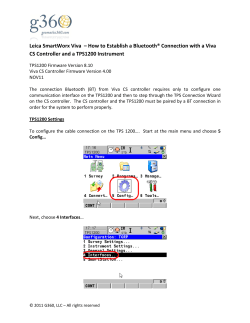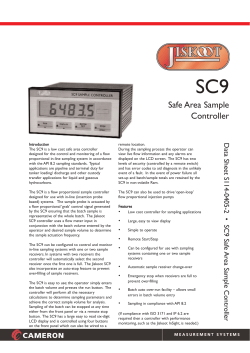
DESIGN METHODS FOR DIGITAL CONTROLLERS, SAMPLE- RATE
CONTROL SYSTEMS, ROBOTICS, AND AUTOMATION – Vol. II - Design Methods for Digital Controllers, Sample-Rate Paraskevopoulos P.N. DESIGN METHODS FOR DIGITAL CONTROLLERS, SAMPLERATE Paraskevopoulos P.N. National Technical University of Athens, Greece Keywords: digital controller, root locus, Bode diagrams, Nyquist diagrams, PID controllers, optimal control, sample rate Contents U SA NE M SC PL O E – C EO H AP LS TE S R S 1. Design Methods for Digital Controllers 1.1. Introduction 1.2. Discrete-Time Controller Design Using Indirect Techniques 1.3. Direct Digital Controller Design via the Root-Locus Method 1.4. Direct Digital Controller Design Based on the Frequency Response 1.4.1. Introduction 1.4.2. Bode Diagrams 1.4.3. Example 1 1.4.4. Nyquist Diagrams 1.5. The PID Controller 1.6. State-Space Design Methods 1.7. Optimal Control 2. Sample Rate 2.1. Introduction 2.2. Example 2 Glossary Bibliography Biographical Sketch Summary There are several methods for designing a digital controller. One method is to discretize the existing continuous-time controller. The most popular method is to design the digital controller directly by extending all known continuous-time design methods to the case of discrete-time systems. Following this approach, we present digital controller design methods via root locus, Bode diagram, and Nyquist diagrams. A brief discussion is presented with regard to the PID controllers, state-space design methods, and optimal control for discrete-time systems. In discretizing continuous-time systems the sample rate is of great concern, since it may seriously affect the performance of the closed-loop system. This is demonstrated by varying the sampling rate and observing its strong influence upon the root locus of the closed-loop system. 1. Design Methods for Digital Controllers 1.1. Introduction ©Encyclopedia of Life Support Systems (EOLSS) CONTROL SYSTEMS, ROBOTICS, AND AUTOMATION – Vol. II - Design Methods for Digital Controllers, Sample-Rate Paraskevopoulos P.N. The classical discrete-time controller design methods are distinguished into indirect and direct techniques. Indirect techniques: Using these techniques, a discrete-time controller Gc ( z ) is determined indirectly as follows. Initially, the continuous-time controller Gc ( s ) is designed in the s-domain, using well-known classical techniques (e.g. root-locus, Bode, Nyquist). Then, based on the continuous-time controller Gc ( s ) , the discrete-time controller Gc ( z ) may be calculated using one of the discretization techniques presented in article Discrete-Time Equivalents to Continuous Time Systems. The indirect techniques are presented in Section 1.2. U SA NE M SC PL O E – C EO H AP LS TE S R S Direct techniques: These techniques start by deriving a discrete-time mathematical model of the continuous-time system under control. Subsequently, the design is carried out in the z-domain, wherein the discrete-time controller Gc ( z ) is directly determined. The design in the z-domain may be done either using the root-locus method (see Section 1.3) or the Bode and Nyquist diagrams (see Section 1.4). Special attention is given to PID discrete-time controller design (Section 1.5).This three-term controller is most popular in industrial applications. 1.2. Discrete-Time Controller Design Using Indirect Techniques The practicing control engineer often has greater knowledge and experience in designing continuous-time than discrete-time controllers. Moreover, many practical systems already incorporate a continuous-time controller that we desire to replace with a discrete-time controller. The remarks above are the basic motives for the implementation of indirect design techniques for discrete-time controllers mentioned in Section 1.1. Indirect techniques take advantage of the knowledge and the experience the designer has for continuous-time systems. Furthermore, in cases where a continuoustime controller is already incorporated in the system under control, it facilitates the design of a discrete-time controller. Consider the continuous-time closed-loop control system shown in Figure 1 and the discrete-time closed-loop control system shown in Figure 2. The indirect design technique for the design of a discrete-time controller may be stated as follows. Let the specifications of the closed-loop systems shown in Figures 1 and 2 be the same. Assume that a continuous-time controller Gc ( s ) , satisfying the specifications of the closed-loop system shown in Figure 1, has already been determined. Then, the discrete-time controller Gc ( z ) shown in Figure 2 may be calculated from the continuous-time controller of Figure 1, using the discretization techniques presented in article Discrete-Time Equivalents to Continuous Time Systems. It is remarked that in replacing a continuous-time controller by a digital controller, a zero-order hold (ZOH) is introduced. This causes additional phase lag, a fact, which influences the closed-loop system performance. 1.3. Direct Digital Controller Design via the Root-Locus Method ©Encyclopedia of Life Support Systems (EOLSS) CONTROL SYSTEMS, ROBOTICS, AND AUTOMATION – Vol. II - Design Methods for Digital Controllers, Sample-Rate Paraskevopoulos P.N. The root-locus method is a direct method for determining Gc ( z ) and is applied as follows. Consider the closed-loop system shown in Figure 3. The transfer function H(z) of the closed-loop system is H ( z) = G( z) 1 + G( z) F ( z) (1) The characteristic equation of the closed-loop system is 1 + G( z) F ( z) = 0 (2) For linear time-invariant systems, the open-loop transfer function G ( z ) F ( z ) has the form m U SA NE M SC PL O E – C EO H AP LS TE S R S ∏ ( z + zi ) G( z)F ( z) = K i =1 n (3) ∏ ( z + pi ) i =1 Substituting (3) in (2) yields the algebraic equation n m ∏ ( z + pi ) + K ∏ ( z + zi ) = 0 i =1 i =1 Figure 1. Continuous-time closed-loop system Figure 2. Discrete-time closed-loop control system ©Encyclopedia of Life Support Systems (EOLSS) (4) CONTROL SYSTEMS, ROBOTICS, AND AUTOMATION – Vol. II - Design Methods for Digital Controllers, Sample-Rate Paraskevopoulos P.N. Figure 3. Discrete-time closed-loop system Definition 1: The root-locus of the closed-loop system of Figure 3 is the locus of (4) in the z-domain as the parameter K varies from −∞ to +∞ . Since the poles − pi and the U SA NE M SC PL O E – C EO H AP LS TE S R S zeros − zi are, in general, functions of the sampling time T, it follows that for each T there corresponds a root-locus of (4), thus yielding a family of root-loci for various values of T. The root-locus of (4) is constructed using the well-known simple root-locus rules. 1.4. Direct Digital Controller Design Based on the Frequency Response 1.4.1. Introduction The well-established frequency domain controller design techniques for continuoustime systems can be extended to cover the case of discrete-time systems. At first, one might think of carrying out this extension by using the relation z = e . Making use of this relation, the simple and easy to use logarithmic curves of the Bode diagrams for the continuous-time case cease to hold for discrete-time systems (that is why the extension sT is not recommended). To maintain the simplicity of the via relation z = e logarithmic curves for the discrete-time systems, we make use of the following bilinear transformation sT z= 1 + Tw / 2 2 ⎡ z − 1⎤ or w = ⎢ 1 − Tw / 2 T ⎣ z + 1 ⎥⎦ (5) The transformation of a function of s to a function of z based on the relation z = e , and subsequently the transformation of the resulting function of z to a function of w based on Eq. (5), are presented in Figure 4. The figure shows that the transformation of the left-half complex plane on the s-plane transforms into the unit circle in the z-plane sT via the relation z = e , whereas the unit circle on the z-plane transforms into the lefthalf complex plane in the w-plane, via the bilinear transformation of Eq. (5). sT ©Encyclopedia of Life Support Systems (EOLSS) U SA NE M SC PL O E – C EO H AP LS TE S R S CONTROL SYSTEMS, ROBOTICS, AND AUTOMATION – Vol. II - Design Methods for Digital Controllers, Sample-Rate Paraskevopoulos P.N. Figure 4. Mappings from the s-plane to z-plane and from z-plane to w-plane At first sight, it seems that the frequency responses would be the same in both the s and the w domain. This is actually true, with the only difference that the scales of the frequencies w and v are distorted, where v is the (hypothetical or abstract) frequency in the w-domain. This frequency “distortion” may be observed if in Eq. (5) we set w = jv and z = e w w = jv iωT , yielding = jv = = 2 ⎡ z − 1⎤ T ⎢⎣ z + 1 ⎥⎦ z = e jωT 2 ⎡ e jωT − 1 ⎤ 2 ωT ⎢ jωT ⎥ = j tan 2 T ⎣e T + 1⎦ Therefore v= 2 ωT tan T 2 (6) Since ωT ωT (ωT )3 tan = − + ... 2 2 8 it follows that for small values of ωT we have that tan (7) ωT 2 ≅ ωT 2 . Substituting this result in equation (6) we have v ≅ ω , for small ωT (8) Therefore, the frequencies ω and v are linearly related if the product ωT is small. For ©Encyclopedia of Life Support Systems (EOLSS) CONTROL SYSTEMS, ROBOTICS, AND AUTOMATION – Vol. II - Design Methods for Digital Controllers, Sample-Rate Paraskevopoulos P.N. greater ωT, Eq. (8) does not hold true. Figure 5 shows the graphical representation of Eq. (6). It is noted that the frequency range −ω s / 2 ≤ ω ≤ ω s / 2 in the s-domain corresponds to the frequency range −∞ ≤ v ≤ ∞ in the w-domain, where ω s is defined by the relation (ω s / 2)(T / 2) = π / 2 . - U SA NE M SC PL O E – C EO H AP LS TE S R S TO ACCESS ALL THE 20 PAGES OF THIS CHAPTER, Click here Bibliography Ackermann J. (1985). Sampled Data Control Systems: Analysis and Synthesis, Robust System Design, pp. 596. New York, NY, USA: Springer Verlag. [This book presents all the essential aspects of digital control systems.] Astrom K.J. and Hanglund T. (1995). PID Controllers: Theory, Design and Tuning, pp. 343. NC, USA: Instrument Society of America. [This is a widely used textbook that presents essential principles and design of PID controllers.] Astrom K.J. and Wittenmark B. (1997). Computer Controlled Systems: Theory and Design, 3rd edn, pp. 555. Englewood Cliffs, NJ, USA: Prentice-Hall. [This widely used textbook presents essential principles and design of digital feedback control systems.] Franklin G.F., Powell J.D., and Workman M.L. (1990). Digital Control of Dynamic Systems, 2nd edn, pp. 742. London, UK: Addison-Wesley. [This widely used textbook presents essential principles and design of digital feedback control systems.] Houpis C.H. and Lamont G.B. (1985). Digital Control Systems, pp.736. New York, NY, USA: McGraw Hill. [This widely used textbook presents essential principles and design of digital feedback control systems.] Katz P. (1981). Digital Control Using Microprocessors, pp. 293. London, UK: Prentice-Hall. [This book presents all the essential aspects of digital control using microprocessors.] Kuo B.C. (1975). Automatic Control Systems, 3rd edn. Englewood Cliffs, NJ, USA: Prentice-Hall. [This widely used textbox presents essential principles and design of feedback control systems.] Kuo B.C. (1992). Digital Control Systems, pp. 561. Orlando, FL, USA: Saunders College. [This widely used textbook presents essential principles and design of digital feedback control systems.] Ogata K. (1995). Discrete-Time Control Systems, 2nd edn, pp. 768. Englewood Cliffs, NJ, USA: Prentice-Hall. [This widely used textbook presents essential principles and design of digital feedback control systems.] Paraskevopoulos P.N. (1996). Digital Control Systems, pp. 383. London, UK: Prentice-Hall. [This is a widely used textbook that presents essential principles and design of digital feedback control systems.] Paraskevopoulos P.N. (2001). Modern Control Engineering. New York, NY, USA: Marcel Dekker. [This widely used textbox presents essential principles and design of feedback control systems.] Phillips C.L. and Nagle H.T. Jr. (1984). Digital Control System Analysis and Design, pp. 685, Englewood Cliffs, NJ, USA, Prentice-Hall. [This is a widely used textbook that presents essential principles and design of digital feedback control systems.] ©Encyclopedia of Life Support Systems (EOLSS) CONTROL SYSTEMS, ROBOTICS, AND AUTOMATION – Vol. II - Design Methods for Digital Controllers, Sample-Rate Paraskevopoulos P.N. Santina M., Stubberud A., and Hostetter G. (1994). Digital Control System Design, pp. 816. New York, NY, USA, Oxford University Press. [This widely used textbook presents essential principles and design of digital feedback control systems.] Ziegler J.G. and Nichols N.B. (1942). Optimum settings for automatic controllers, Transactions of the American Society of Mechanical Engineers, 64, pp. 759–768. Biographical Sketch U SA NE M SC PL O E – C EO H AP LS TE S R S P.N. Paraskevopoulos was born in Doxa Arkadias, Greece, in 1941. He received his Bachelor’s (1964) and Master’s (1965) Degrees from the Illinois Institute of Technology and his Ph.D. from the University of Patras, Greece (1976). He has been Professor of Control in the Democritus University of Thrace (1977 to 1985) and in the National Technology University of Athens (1985 to date). He has published over 130 journal papers and 70 conference papers in the field of control engineering. He has written 10 books on control theory in Greek and two in English (see Bibliography). He is the Founder and Director of the Control Systems Laboratory, which is among the very best of its kind in Europe. His current research and development interests are mainly in system identification, systems theory, controller design for linear and nonlinear multivariable systems, computer-controlled systems, optimal and algebraic control, adaptive and robust control, control of discrete-event systems; and industrial applications, particularly in process industries such as refineries, papers, cement, plastic, mill, aluminum, and food. ©Encyclopedia of Life Support Systems (EOLSS)
© Copyright 2025

![[ ] sin [ ] - Oregon State University](http://cdn1.abcdocz.com/store/data/000701149_1-0bf1cae8507d705aa8597319f112cba3-250x500.png)












